At the Center for Folklife and Cultural Heritage, I am one of two interns working to create educational tools that will assist Folklife magazine’s efforts to become more of an educational resource utilized by teachers in K-12 education. The portion of my internship I have enjoyed the most are the interviews I have conducted with Smithsonian employees. These interviews have framed my own understanding of my Folklife assignment. One of my first tasks is to create a lesson plan template that can be reused by Folklife staff to create more lessons. For instance, I met with Jen Mellizo, a contracted educator with a BA in Music Education, and Logan Clark, a PhD in Ethnomusicology. These two individuals work for the Smithsonian’s independent music label Folkways Recordings. Folkways Recordings was given a grant to finance the creation of educational resources. Mellizo and Clark determined that it would be a missed opportunity for Folkways to not use the amazing music catalog it has at its disposal as the basis for educational experiences. Consequently, they developed an educational resource titled Folkways Music Pathways.
According to their site, Folkways Music Pathways is “an integrated, thematic, and fully customizable journey of discovery that places music from the Smithsonian Folkways collection and other Smithsonian Institution primary resources at the center of the educational experience.” Mellizo and Clark’s goal was to create a curated experience that incorporated songs in a meaningful way for teachers. The first couple of lessons were constructed by Mellizo who has a music educator background. Later lessons relied on the expertise of musicians and content experts.They are currently retooling their created lessons for districts within DC Public Schools. The creator would be a cultural music artist working jointly with Jen. The lessons would be vetted by a content expert (PhDs) for accuracy, educators and educational PhDs for pedagogical purposes.
By talking to Mellizo and Clark, I was reassured that my thought process regarding the conceptualization of my lesson plan template was correct. I determined that it would be best to use the College, Career, and Civic Life (C3) Framework for Social Studies State Standards as the foundational standards for Folklife lesson plans. Due to the fact, social Studies is multidisciplinary, it serves as an excellent basis for creating lesson plans as so many subject matters can be interconnected with each other.
To create further positive experiences like this, I can reach out to speak to more individuals to discuss any revisions I should make for my project. Additionally, I have come to realize that I find it easier to work with another person to conceptualize a project. My internship supervisor has thus far given me and my “co-intern” free reign to conceptualize and develop our project with as many resources as we need from Folklife Magazine. The issue was that Folklife covers so much content that it was difficult to narrow down to a specific topic that could be transformed into an educational resource. We decided to narrow down our topic to immigration and migration. The problem was that immigration and migration is still an extensive topic . As a result, I felt stuck on the next steps to take in order to fully develop a lesson plan for it. After speaking to my co-intern, we decided it might be best to start with a foundational lesson on culture that could then lead into the heavier topic of immigration and migration. This was the best solution as it helped us draft an outline for a lesson plan introducing culture to middle schoolers to eventually lead into a major lesson on immigration and migration.
Internship Blog Reflection
The Smithsonian Center for Folklife and Cultural Heritage (CFCH)’s mission is to use culture as a tool for building understanding, strengthening communities and reinforcing the shared humanity of the human race. CFCH functions as a research center and educational subdivision of the Smithsonian Institution. CFCH prides itself on understanding and maintaining cultural heritage across the United States and the world. The Center is in charge of many different initiatives. These initiatives include the “Smithsonian Folklife Festival, Smithsonian Folkways Recordings, the Cultural Vitality Program, exhibitions, documentary films and videos, symposia, publications, and educational materials.”
Folklife Magazine, a digital platform, is one of the many publications managed by the Center. The magazine’s goal is to explore how culture shapes our lives by publishing stories about music, craft, language, celebrations, activism, and the individuals and communities who sustain these traditions.” However, the magazine is having difficulties being utilized as an educational tool. As an intern, I am expected to work with the Center’s communications, editorial, and curatorial teams to review Folklife Magazine content in order to build out a series of new web pages or other digital tools to aggregate content for K-12 educational purposes.
Objectives associated with my role include:
- Reviewing and developing understanding of the Center’s existing cultural education resources.
- Deepening understanding of cultural heritage by engaging with content from a wide range of heritage practices and communities.
- Gaining knowledge of the Center’s core work areas.
- Developing relationships with colleagues from across the Center’s departments (expanding professional network).
- Working on an interdisciplinary team of editors, content producers, curators, and collaborating partners.
- Organizing existing content for K-12 educational purposes.
- Working with the Center’s web content management system, laying out web pages utilizing HTML coding.
- Building presentation skills by providing a brown bag presentation about work to the Center’s staff.
I was selected by the Center for Folklife and Cultural Heritage because of my background as an educator. I have taught for five years and I have both a Bachelor’s Degree in History and a Master’s of Arts Degree in Teaching. I currently teach 8th grade US History. As a result, I am assigned to assist in curating Folklife magazine into an educational tool. I am most excited about being able to receive firsthand experience in the development of content for the Smithsonian. Typically, when I practice creating educational content I become more enthusiastic about teaching. I think it is due to the fact that I am able to be creative and experiment with different educational tools.
Presenting the Past-Private Collections and Auction Companies
As I write this post, I have Netflix’s original series King of Collectibles: The Goldin Touch paused on my television. The reason why I am watching this show is because it is associated with an issue I am interested in investigating-the issue of private collections and auction companies in the acquisition of historical artifacts. For those that do not know, the King of Collectibles is a reality show dedicated to following the business dealings and exploits of a leading auction house, Goldin Auctions. The reality series shows viewers the auction house’s acquisition of rare collectibles ranging from sports memorabilia to pokemon cards to anything that is rare and worth thousands to millions of dollars. It is often unbelievable what Goldin’s employees come across and even more unbelievable just how much nameless millionaire buyers will pay to acquire what are without a doubt one of a kind historical items.
In season two of the reality series, Ken Goldin, the founder and CEO of Goldin Auctions, knows that his company is the leader in the selling and acquisition of sports memorabilia but has professed that it is not enough. Goldin also wants his company to be a leader in the acquisition and selling of historical documents and artifacts. Goldin recently hired a new “chief authenticator”, John Reznikoff, to demonstrate the authentication of historical documents, art, technology and other items that appear in the series. Now, this is where the show kind of loses me as a general viewer and turns me into a student of ethics, history and the digital public humanities.
The King of Collectibles is far from the first reality series to exemplify the purchase and selling of historical items; other shows like American Pickers, and Pawnstars have made it a central part of their business model and storylines. But, Goldin has a more specific clientele that is encompassed by mostly unnamed millionaires. The idea of acquiring and selling historical artifacts to this type of clientele who will then most likely keep the items stocked in a personal collection for no one else to see for years to come makes me want to borrow one of Indiana Jones’ most famous lines, “It belongs in a museum!”
I myself am a collector and come from a family of collectors and partake in the purchase of affordable antiques at small family owned shops or booths in outlets in historic downtowns. I am also not venturing to seek out items owned by Thomas Jefferson or Malcolm X. I feel like historical items that contribute to a nation’s history or even to world history should be accessible to the greater public. This doesn’t mean that it has to be on view at a museum but it can be available digitally for people to see and utilize for research, education or their own interest. On the other hand, maybe if I did have a million dollars I would spend it on something of grand importance in the hopes of preserving it. Perhaps that could be the true goal of these private collectors instead of the items serving solely as a purchase to hide money laundering?
I feel as though this subject matter only brings up more questions related to ethics, historical preservation and shared historical authority. In his reality series, Goldin does not seem to be someone who is entirely without morals but he could be playing it up for the cameras. That said, I would be curious to see if his company is developing a policy on the acquisition of historical artifacts and their own standards related to the type of client they would wish to purchase the items.
Fifth Piece of the Puzzle
My project idea is to create an introductory historical thinking activity for middle school students. The project is focused on teaching students how to contextualize, source, corroborate and close read. The project also serves as a tool teachers can use and implement in their own classes. I have created a teacher’s guide and most of my student interactive exhibits. Each exhibit serves as a lesson for historical thinking. I have broken the exhibits into steps and have incorporated activities students can complete.
Graphic organizers are used often in order to serve as a Universal Design for learning and a differentiation tool.
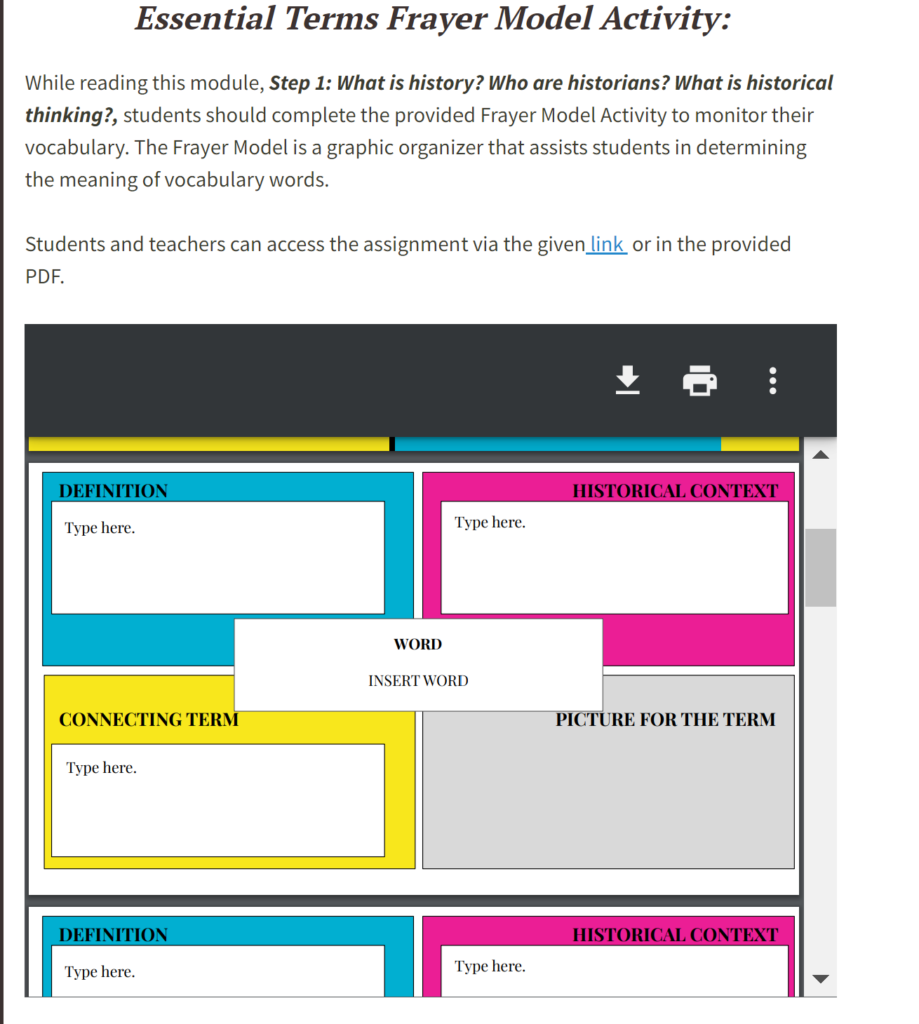
To make my project friendlier to students, I have included videos and guiding images like Bitmojis to provide further direction on the modules and assignments.
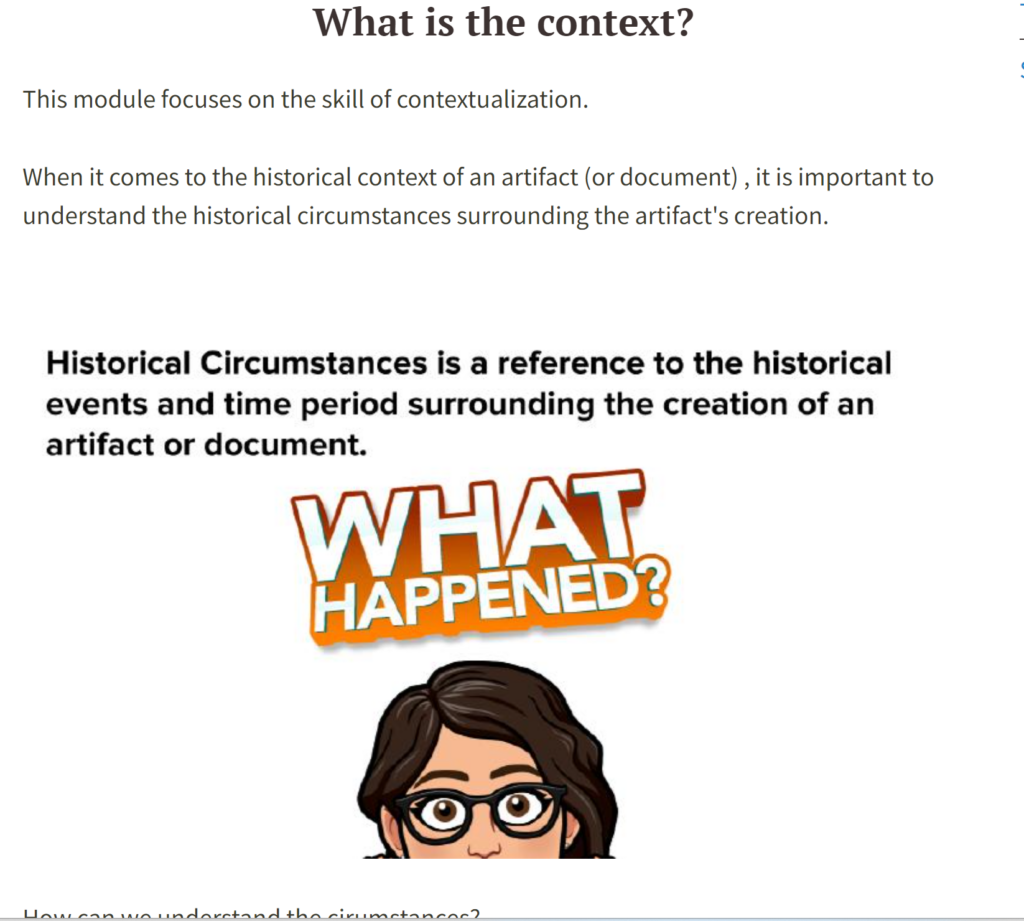

I completed my fourth exhibit related to historical context. I decided to have students identify the context for two lunch boxes that can also be used for a future activity on corroboration. The two lunch boxes are Peanuts by Shulz and Wee Pals Kid Power. I selected these two lunch boxes since Peanuts creator Charles Shulz and Wee Pals creator Morrie Turner were contemporaries and colleagues. Wee Pals was inspired by Peanuts and was created in the midst of the Civil Rights Movement.
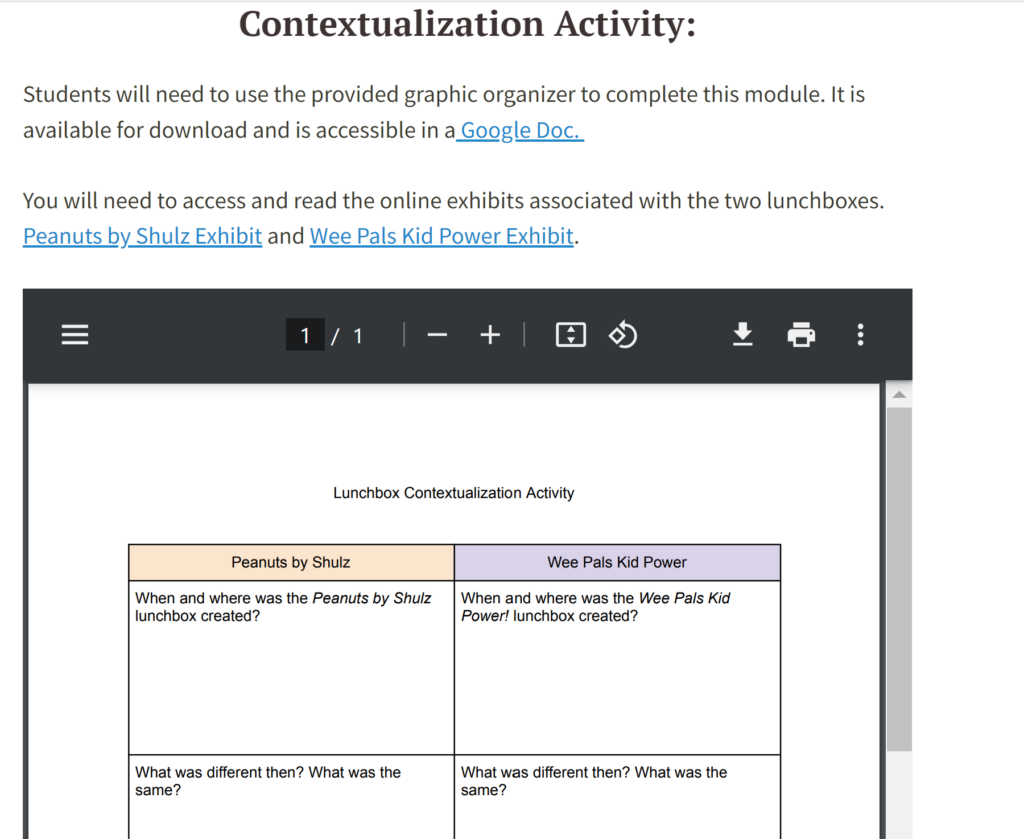
I feel as though there are a lot of things students can dig into for historical context with these two artifacts. In my context exhibit, I also provided oral history interviews with Shulz and Turner so students can hear from the cartoonists themselves about the significance of their creation. They also serve as additional multimedia primary sources students can use to eventually answer the compelling question.

I still need to complete the rest of my exhibits. These exhibits are related to corroboration, empathy, students answering the compelling question and students sharing and reflecting on the activity. I also need to create instructional videos for teachers and students in order to explain how to go through the site.
I am going to resolve these challenges by just dedicating time to completing the exhibits this week and searching through my district’s resource to reapply them to my exhibits.
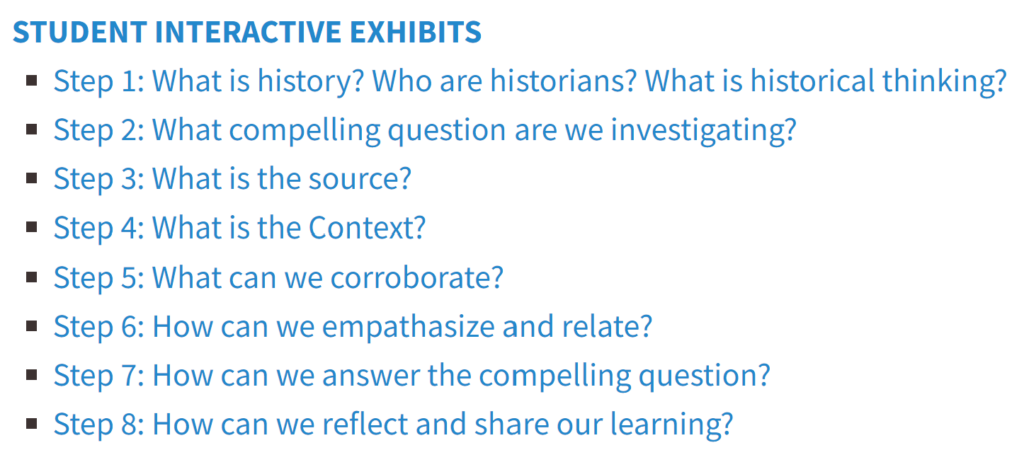
7/1 Reflection and Project Update
Reflection:
It was helpful to see what previous students accomplished with their digital projects. I had issues determining my learning activity’s layout and the types of activities I could incorporate. I saw that previous students implemented google forms as a means to engage audiences with their site’s content. I played around with embedding google slides on my OMEKA site but struggled with the Google Drive Omeka plug-in. I installed it but the embedded Google Slides link does not fit in with the overall structure of the site. I then decided to install the PDF embed plug-in to upload PDFs to my site and make them accessible to site visitors for easy download. I also played around with a digital technique I learned during Covid-19 that allows me to embed links to sites that enable users to make an automatic copy of google slides, docs and sheets. Listening to other students’ digital projects also helped me see the usefulness in creating a teacher’s guide. Since I made my teacher’s guide I was able to see exactly what I want teachers and students to be able to accomplish with my project. Additionally, I saw that a popular technique amongst these digital projects was the usefulness in posing historical thinking questions to users as a means of inquiry based learning.
In terms of my project, I was able to make some developments with the layout to solidify my original ideas.
To make it clear that my site is multipurpose in its function to educate, I developed pages for a teacher’s guide and student interactive exhibits. The teacher’s guide will serve as an open letter to teachers to explain the site’s educational purpose and the designed historical thinking activity. In the teacher’s guide, I included a Schoology Access Request Form so educators can request the Schoology version of the historical thinking activity that teacher’s can easily implement on the Schoology class pages. I was able to embed my OMEKA site into a Schoology assignment for students to gain easy access to it. The Teacher’s guide also establishes the activity’s learning objectives and the disciplinary literacy standards. The teacher’s guide is not yet complete as I would like to include an instructional video that goes over the site’s functionality.
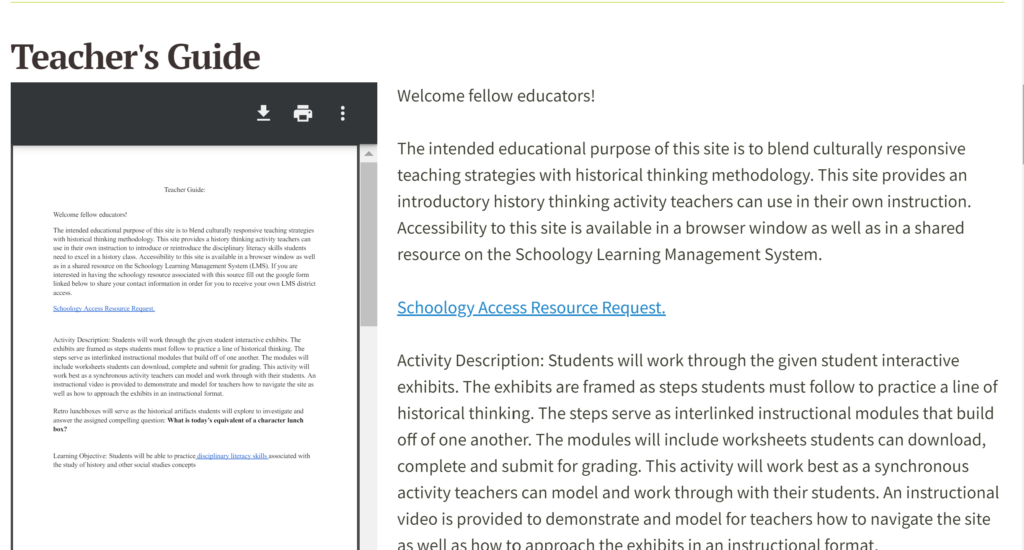
For my student interactive exhibits, I decided to separate the historical learning activity into interrelated steps. The steps correlate with a historical thinking skill. As of this moment, there are a total of 8 steps.

The steps serve as lessons on a specific topic/historical thinking skill. In step 1, I included teaching items from Stanford’s Digital Inquiry Group (DIG). DIG’s historical thinking tools have been useful in my own teaching so I decided to feature them on my site in order to define terms like corroboration, sourcing, close reading and contextualization. I am also embedding graphic organizers in my learning activity to serve as worksheets that can be completed as part of the lesson. Students and teachers can access these worksheets as a PDF or google doc. I installed plug-ins like PDF Embed to make documents available to site visitors. These worksheets are included in a collection titled “Educational Resources” for organizational purposes.

Next Steps:
I need to complete the written instructions for steps 4-8. I need to select and embed the worksheets I will be utilizing for steps 4-8. I need to create instructional videos that will guide users through the historical learning activity.
Retro Lunchboxes Advertising

Films as an Educational Tool and Digital Story Telling
I am not going to hide the fact that I have used film in my work as a social studies teacher so I will be honest and say I have used film as a means to show my students how things would have looked and sounded like in the past. I have also used film as a means of giving character and humanity to historical figures and participants. Film is also a great way to put historical figures and events in context. Eighth grade students have difficulty understanding/conceptualizing the past because they have lacked an exposure to it. The cinema is not as popular as it once was and youth culture is more fragmented than unified when it comes to popular media due to cellphones and social media. After reading and learning what I have, I am planning to use film a lot more than I originally have. The line of historical inquiry I will use will rely on a similar line of questioning associated with photo analysis. Who is the creator? When was the film created? When and where does the film take place? What historical event(s)/people are depicted? And, so on. However, a different line of questioning will be given to students based on specifics associated with the given film.
I have used clips from films like Last of the Mohicans (1992), John Adams (HBO Mini series, 2008) and Gone with the Wind (1939) to give context to historical moments, figures, and participants as well as to give reasoning for the causes and effects behind historical events. I am on the lookout for other films and television programs that are related to historical events from the 1700s to 1870s.
Learners can benefit from digital story telling because it allows them to conduct a more in depth study of historical content. Digital story telling can serve as a step up from traditional methods like essay writing by enabling students to interact with historical research in an innovative way. Students are more likely to experiment and take risks with new methodologies and multimedia resources that re-represent historical data and information. These projects can then be shared and revised more easily with collaborators and audiences.
Review: Brats by Andrew McCarthy
Brats, June 2024, director, Andrew McCarthy, producers: Adrien Buttenhuis and Derrick Murray, film accessed via Hulu streaming service. Film is a documentary that uses primary sources such as film reels, television interviews, news articles, film clips, interviews from eyewitnesses who were involved with the “Brat Pack” of the 1980s. “Experts” are consulted as secondary sources to explain the 80s cultural phenomenon and the impact of “Brat Pack” films on the cultural zeitgeist.
Thematically, Brats focuses on the films that transformed the cultural lexicon of the 1980s, the trade off of fame, and McCarthy’s personal mission to confront the past.
The film was directed by Andrew McCarthy and it follows him in his journey to reconnect with his old castmates, contemporaries, and individuals who are “experts” about the impact of the “Brat Pack” films of the 1980s on popular culture. The conflict McCarthy hoped to confront and resolve with his film were the consequences associated with an article published on June 10th, 1985 in New York Magazine titled “Hollywood’s Brat Pack.” The article was written by journalist David Blum and he is credited with creating the famous phrase “Brat Pack” to identify a group of young actors in the early 1980s who starred as the leads in many feature films geared towards a younger audience. McCarthy makes it clear that he believed the article was “scathing” and damaging to himself and young actors of the day and their professional reputations. More than anyone would realize, the term “Brat Pack” lived on in the cultural zeitgeist to permanently identify the actors association with the “Brat Pack.” The phrase itself was created by a member of the media, David Blum. The overall media ran with it and the phrase snowballed into something that would impact actors like Emilio Estevez, Judd Nelson, Rob Lowe, Andrew McCarthy, Molly Ringwald, Demi Moore, and Ally Sheedy for the rest of their lives. These actors would be forever known as part of the “Brat Pack” in popular memory, culture and history. McCarthy is ultimately critical of the article’s depiction of young actors and how the term “Brat Pack” impacted his life and personal relationships. He uses his disdain as motivation to contact members of the “Brat Pack” to then revisit their shared unwanted connection and to hopefully confront his past.
The film’s historical accuracy is dependent on the testimonies of “Brat Pack” members, journalists like Malcolm Gladwell and Susannah Gora; pop culture critic, Ira Madison III; directors like Brett Easton Ellis and Howard Deutch; producer Lauren Shuler Donner, talent manager Loree Redkin, casting director Marcie Liroff and the infamous David Blum. We are meant to trust these testimonies that are then edited and interwoven with interview footage and photos that serve as evidence to how the actors felt in reaction to Blum’s article. Photographs and newspaper clippings from the 1980s were used as primary sources. Film clips from St. Elmos Fire, Pretty in Pink, Class, the Breakfast Club are used to depict the relationship between the actors who were interviewed and the roles they played. McCarthy also uses two quick cuts of words featured in Blum’s article.
The film’s historical inaccuracies stem from McCarthy withholding David Blum’s article. McCarthy never shows the full article to the audience. He only shows snippets of sentences utilized by Blum to describe his perception on how easy it was for young actors to skip a proper theater arts education to achieve success. McCarthy also shows sentences critical of Emilio Estevez who is declared by Blum to be the “president” of the “Brat Pack.” A major inaccuracy arising from the article being withheld is that McCarthy gives the impression that many young actors were mentioned by name and were subsequently trashed by Blum. In reality, the main subjects of the article were Emilio Estevez, Judd Nelson and Rob Lowe. Demi Moore (who was interviewed as if she was mentioned) was only briefly mentioned as Estevez’s on and off girlfriend while Ally Sheedy (who was also interviewed as if she was mentioned), Molly Ringwald, and Jon Cryer (interviewed as if he was mentioned) were never identified as members of the “Brat Pack.” Blum identifies actors like Matt Dillon, Nic Cage, Tom Cruise, Sean Penn, Kevin Bacon, Matthew Broderick, and Matthew Modine. Like Demi Moore, Andrew McCarthy is briefly mentioned and it was not due to any criticism from Blum. It was due to criticism from Emilio Estevez who openly criticized McCarthy’s acting technique. McCarthy fails to be specific about how the article negatively depicts young actors as a whole. Blum wrote the article after spending time with Estevez, Nelson and Lowe in the New York Club scene. Blum recorded what he saw and heard while he was with the young actors. The content served as the basis for his article.
The Moments:
Time 28:35
The theme associated with the “Brat Packs” impact on the cultural lexicon is made most clear by McCarthy’s interview with Malcolm Gladwell. Although Gladwell is not a pop culture historian, he offers insight on how the “brat Pack” label caught fire. Gladwell explained that the “Brat Pack” label signified a generational transition in Hollywood that was an explicit reference to a pun on the famous “Rat Pack” with Frank Sinatra, Dean Martin and Sammy Davis Jr.. Gladwell explained that the reference itself became a metaphor. Specifically, Gladwell stated “Whenever a term makes that journey to metaphor status, it has a chance to kind of endure. And, you know, it’s also funny. The “Rat Pack” and the “Brat Pack” in sensibility are polar opposites, right? One is anxious, and immature, and trying really hard to figure out their place in the world and the other group doesn’t give a fuck.” Gladwell goes on to explain how the “Brat Pack” was such a cultural phenomenon with youth culture as younger audiences were unified by coming of age films.
1:13:35
Another pivotal moment in the film is when McCarthy speaks to David Blum, the writer of the New York Magazine article that solidified the phrase “Brat Pack.” Blum explains how the term came to be and the context behind its creation. McCarthy first asks Blum about his employment as journalist in 1985 and the original purpose of the article. Blum clarified he was under contract with New York Magazine and the article was meant to be a feature on Emilio Estevez. Estevez invited Blum to have drinks along with Rob Lowe and Judd Nelson. Blum noted how much attention the actors were receiving. Blum explained he was mostly there to observe and did not dislike any of the actors or think of them as brats. Blum’s epiphany on the famous phrase “Brat Pack” came after he had a very big dinner with LA journalists. One of the journalists, Alan Richmond, took into account how much food Blum and other journalists ate as a result of the dinner, coining the phrase “Fat Pack.” Blum was very amused by it. The joke eventually re-emerged in Blum’s head as he was driving around LA, spinning it into the phrase, “Brat Pack” as the title of his article. Blum then began to draft out his ideas, recalling the events of the night he spent with Estevez, Lowe, and Nelson that fell into the actions of what a “brat” would do. Blum stated he did not perceive the phrase as that big a deal or as insulting but he did think the article would receive a reaction.
Teaching and Learning:
I would use this film in the context of history education because it demonstrates how terms/phrases can be taken out of context and serve as products of their time. The term “Brat Pack” symbolizes a point in time in which there was a generational transition in Hollywood films that appealed to a unified youth culture. It also permanently impacted the personal lives of young actors from the 1980s. My students are tasked with textual analysis on a daily basis with historical documents and a lot of the time famous phrases are taken out of context and given a new meaning. I would first do an introductory activity that asks students to think about the trends that exist in popular culture such as the most popular sayings. I would make a list of them and then save them for later. If I had to introduce the film to students, I would play the first 12 minutes of the film in order to establish what popular culture was like in the 1980s and the definition of “Brat Pack.” I would then give them David Blum’s article. I would give them a list of questions associated with the content of Blum’s article. I would ask my students why the term “Brat Pack” could be perceived as a negative and/or positive. I would then ask my students to investigate the origins of the popular sayings they mentioned in the intro activity to learn about their cultural significance and their connotation. Students would then be given background information on all the people associated with the documentary. Students would then be shown the rest of the documentary. They would then be given a survey associated with how they felt about McCarthy’s documentary. The survey would feature questions like were the actor’s victims of David Blum’s article, was the term “Brat Pack” enough to damage an actor’s relationship? Once they answered the survey, I would then give them copies of David Blum’s article once again along with quotes from the actors featured in the documentary discussing his article. I would ask them to compare and note the contrasts in the article and the actors’ statements. Students would then be expected to answer a short answer question about whether or not the article was truly damaging to the reputation of the actors mentioned in the article and documentary. I would want my students to ask questions related to how popular phrases and terms can endure over time.
Images: Third Piece of the Puzzle
I have simplified my navigation settings on my omeka site to make navigation easier and less confusing for my target audience of 8th graders. It was originally cluttered with “unusable” navigation pages that were great in theory but did not serve a useful purpose. I have started to storyboard the instructional pages for my learning activity and I have begun to draft the descriptions I will provide. I am revisiting my county’s curriculum framework in order to make sure I am hitting the necessary indicators and following the necessary foundation for teaching and learning in history. The primary sources I will use will be the lunchboxes I have photographed on the site. My next steps and challenges will include testing to see if I can embed Omeka pages in the Schoology learning management system and building the pages for my site. Although I have relied on my own primary sources for historical analysis, I am depending on articles from our modules to find the best techniques for teaching history especially in relation to historical inquiry and analysis. I am continuing to conduct research on this very issue. The most useful articles for my site will be our most recent module on photography since photo analysis will need to be conducted on my site. I have also utilized a textbook from my college historical methods course called “The Methods and Skills of History: A Practical Guide” to get further ideas on instructional methods.
An image I am using in my final project will be a Marvel Secret Wars lunchbox. Marvel comics, film, and television shows are popular amongst students and will seem pretty relevant for them to discuss and conduct a photo analysis. I will help my students conduct an analysis by asking questions related to:
What do you see? What is included? Who might have purchased this box? How does this box compare to items you have in your possession?
I will also help my students conduct an analysis by modeling and guiding them through the activity.
I do not currently have any questions on developing my final project.
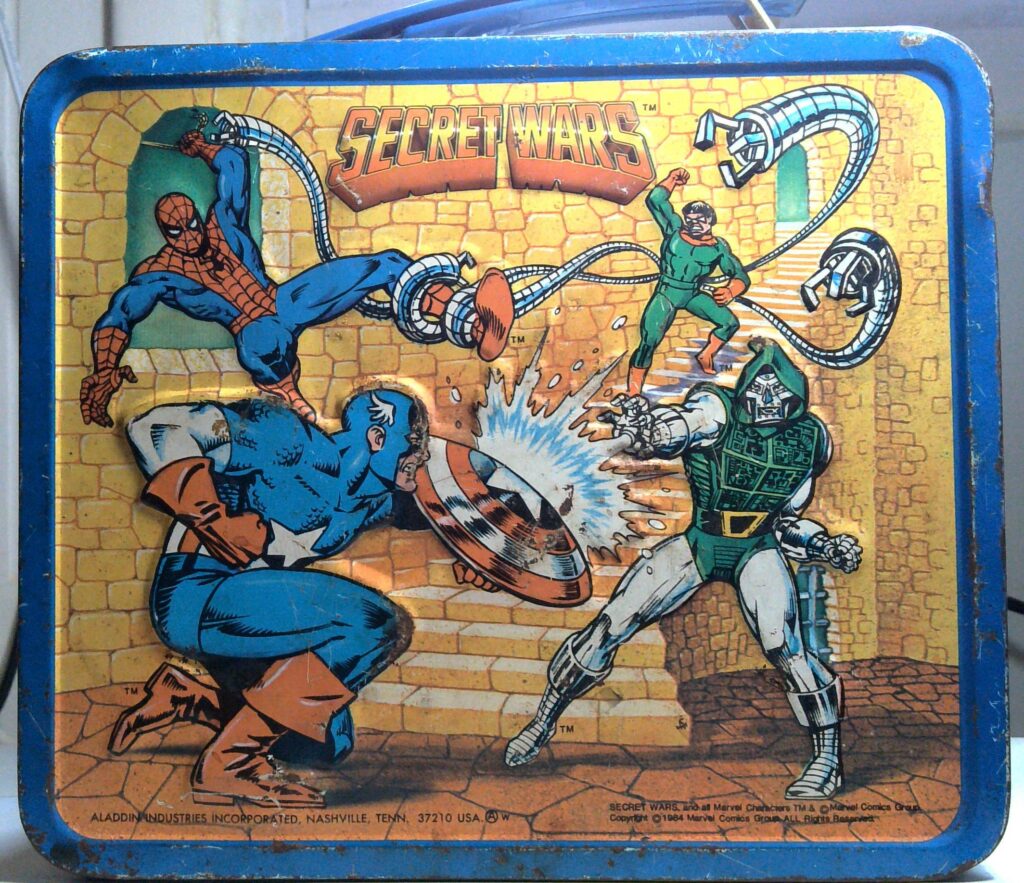


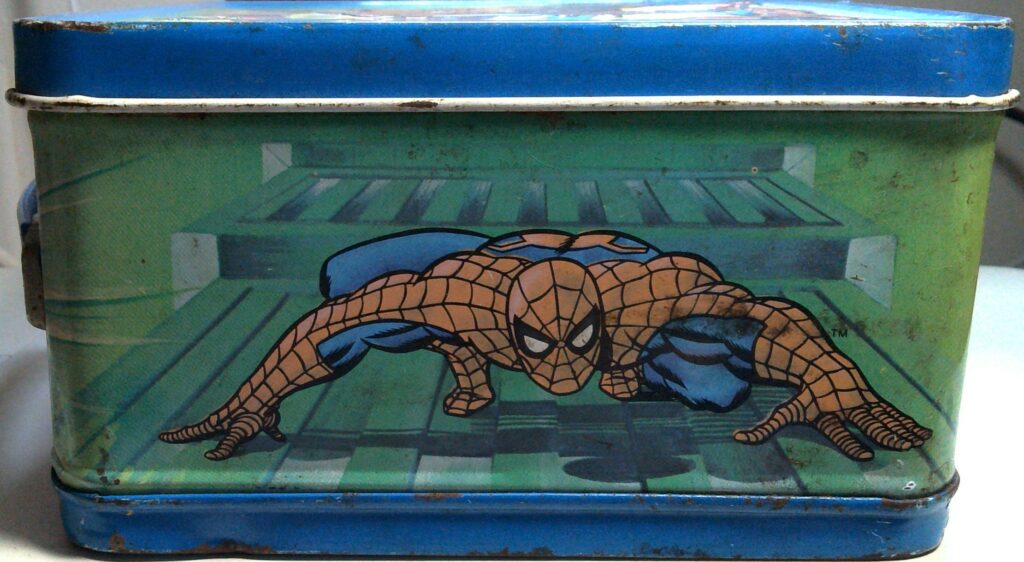
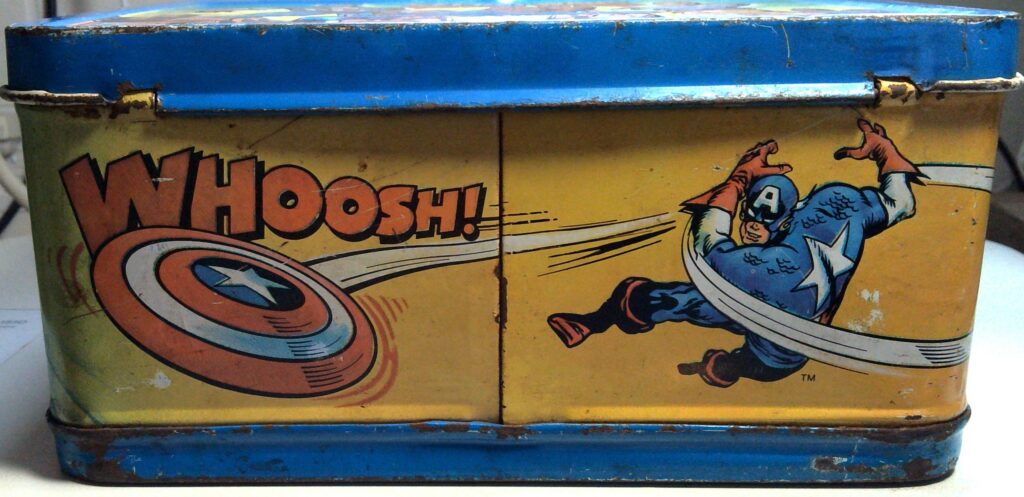
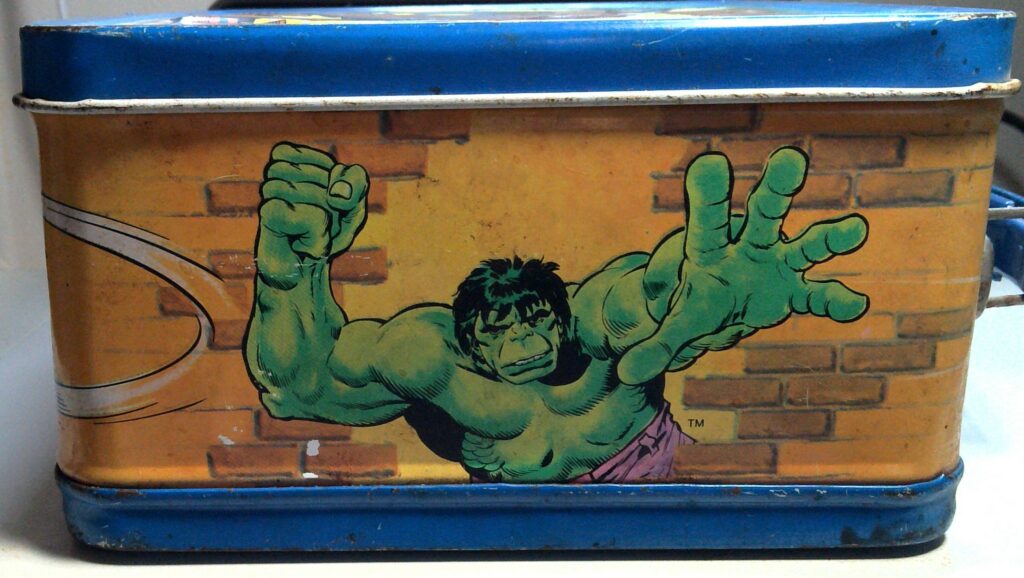
The Second Piece of the Puzzle
Digital media and digital tools can be used to engage 8th grade students with historical content. Digital media can increase student engagement in history and historical thinking by serving as a Universal Design for Learning. Universal Designs for Learning refer to teaching tools that provide students with multiple means for engagement, content representation, as well as action and expression.
This is what is included in Universal Designs for Learning:
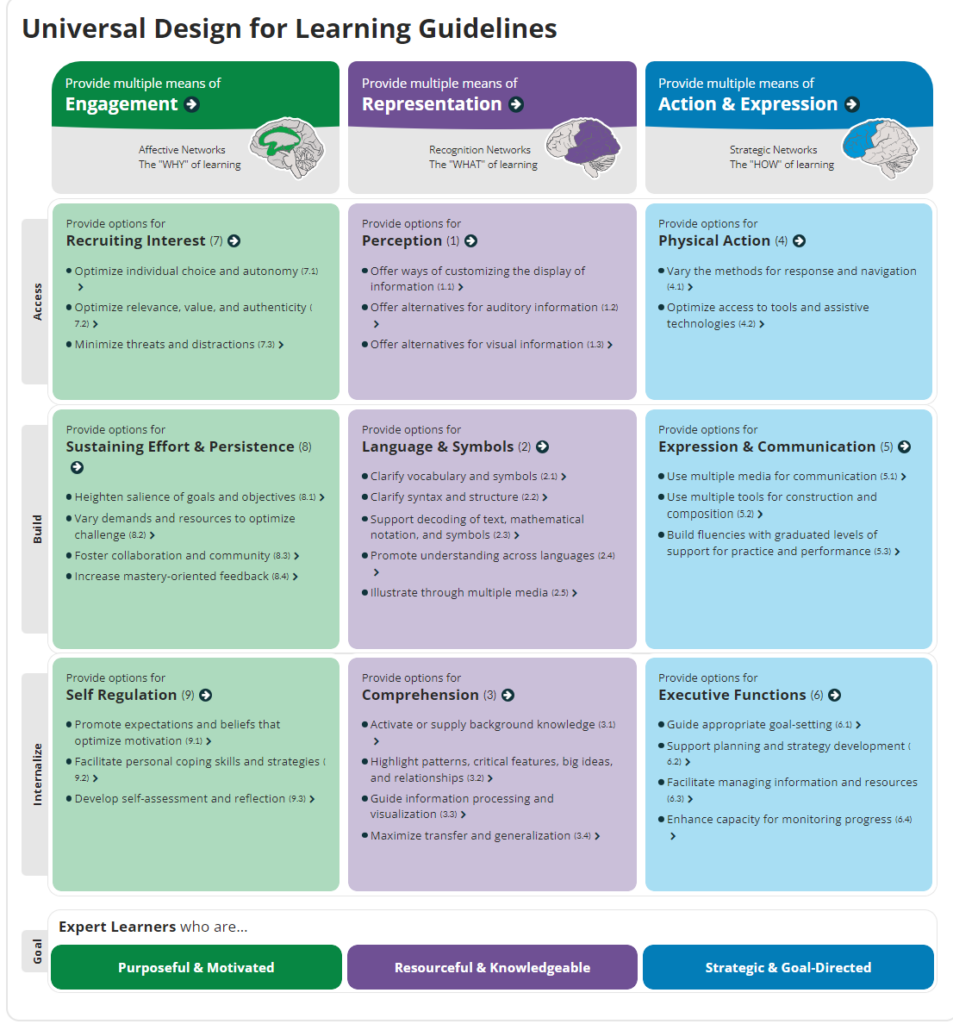
Middle schoolers are much more receptive to activities that are more interactive and visually stimulating. Carl Becker noted the influence of popular media of the 1930s transforming traditional history and popular media continues to do so in the contemporary setting. Students groan at the sight of textbooks as opposed to digital media that provide diverse opportunities for interacting with and learning content. These opportunities can include things like video games, podcasts, videos, films, music, discussion boards and so on. Students with special needs and English Language Learners can especially benefit from the UDLs digital media provides.
My proposed learning activity revolves around an Omeka site I built related to retro lunchboxes. My goal is to create a historical thinking introductory activity that students can complete to review historical concepts shown throughout the site. The digital component of the activity will potentially rely on the creation of tutorial pages that will guide students on how to conduct a historical investigation of the lunchboxes. As this will be the first time students are interacting with a site like this, students will have to follow the instructor through guided practice in the examination of photos and annotations. I may also need to provide video tutorials for students who need extra practice with the act of historical investigation. With these changes and realizations, I have to consider in what ways I can blend/embed an Omeka site into the students’ traditional learning management system of Schoology to make the site easily accessible. Students are used to using Schoology and it is the primary platform I use to give instruction materials and assignments. I will have to experiment to see if there is a way in which I can connect the two platforms.